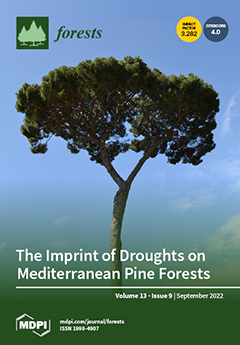Cremastraappendiculata (Orchidaceae) is a perennial medicinal herb, which is included in the national second-class protected plant catalog in China. Due to the influences of climate change and anthropogenic activities, in conjunction with soaring commercial prices, the wild sources of
C.appendiculata have been drastically reduced and are in danger of extinction. Consequently, it is important to predict the distribution of potentially suitable growth/propagation areas for
C.appendiculata under the backdrop of climate change for its protection and sustainable use. For this study, an optimized maximum entropy model was employed to analyze the distribution patterns and changes of potentially suitable regions for
C.appendiculata during different periods since the Last Glacial Maximum (LGM, 18–24 ka). Based on multiple climate change scenarios (SSP1-2.6, SSP2-4.5, SSP3-7.0, and SSP5-8.5), the distribution range of
C. appendiculata was predicted for the 2050s (average for 2041–2060), 2070s (average for 2061–2080), and 2090s (average for 2081–2100). The results revealed that during the LGM period, the highly suitable growth area for
C.appendiculata was 0.28 × 10
4 km
2, which accounted for only 3.26% of the current highly suitable growth area. During the mid-Holocene (MH, 6 ka) period, the area of highly suitable regions increased to 8.38 × 10
4 km
2, which accounted for 99.30% of the present highly suitable growth area. Further, the cumulative existing potentially suitable growth area for
C. appendiculata is 213.9 × 10
4 km
2, which accounts for 22.28% of China’s territory. Of these lands, the low, medium, and high suitable areas are 147.76 × 10
4 km
2, 57.71 × 10
4 km
2, and 8.44 × 10
4 km
2, respectively. The highly suitable areas are primarily distributed across Sichuan, Gansu, Shaanxi, Chongqing, Guizhou, Hubei, and Anhui Provinces. Moreover, in the future the potentially suitable growth areas for
C. appendiculata will decrease to varying degrees. Further, the results of this study found that the relatively low impact areas for
C. appendiculata were mainly distributed across Shaanxi, Sichuan, Chongqing, and Guizhou Provinces. Centroid transfer analysis indicated that the center of potentially suitable growth areas for
C.appendiculata shifted to the northwest in SSP2-4.5 and SSP3-7.0, while they initially shifted to the northwest and then to the southeast in SSP1-2.6 and SSP5-8.5.
Full article





